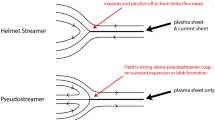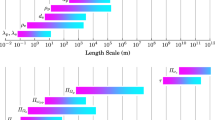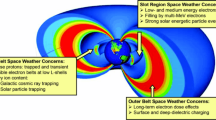Summary
The numerical solution of the spherically symmetric, steady-state Fokker-Planck equation of transport in a system of reference anchored at the Earth with the energy variableT, as measured in a frame moving with the solar wind, shows a good fit to recorded data in interplanetary space during 1965–1968. The boundary condition for a steady-state particle injection at the solar surface considers the energy transformation from the fixed frame into the moving one. Another possible introduction of boundary conditions via the differential current density is also discussed. Densities and gradients in an energy range (≈6 orders of magnitude centred around 1 GeV/nucleon) and radial distances (up to 5 AU) are illustrated in stereographic projections. In our computations the diffusion coefficient is given byK rr=K(r)·K(P), and the densityu reveals itself to be smoothi.e. ε=(v/w)|ϖ Inu/ϖ lnT|≪1. wherew is the particle speed andv is the solar-wind velocity. The radial anisotropy in also presented.
Riassunto
La soluzione numerica dell’equazione di trasporto di Fokker-Planck, nel caso stazionario ed a simmetria sferica, nel sistema di riferimento fisso con la Terra e con energia cineticaT misurata nel sistema del vento solare, è in buon accordo con i dati sperimentali raccolti nello spazio interplanetario negli anni 1965–1968. Si tratta il problema con la condizione al contorno di un’immissione stazionaria di particelle sulla superficie del Sole operando una trasformazione dell’energia dalla terna fissa a quella mobile. Inoltre si prende in considerazione l’introduzione di una ulteriore condizione al contorno attraverso la densità di corrente differenziale. Proiezioni stereografiche mostrano densità e gradienti in un intervallo di energie di 6 ordini di gradezza (centrato intorno ad 1 GeV/nucleone) e fino a distanze radiali di 5 AU. Nei nostri calcoli il coefficiente di diffusione è dato daK rr=K(r)·K(P) e la densitàu appare avere una forma liscia, cioè ε=(v/w)|ϖ Inn/ϖ lnT|≪1, dove ω è la velocità della particella ev è quella del vento solare. Si riportano anche calcoli sull’anisotropia radiale.
Резюме
Писленное рещение сферически-симметричного стационарного транспортного уравнения Фоккера-Планка в системе отсчета, свяэанной с землей, для знергетической переменнойT, измеренной в системе, движущейся с солнечным ветром, обнаруъивает хорошее соответствие с данными, полученными в меъпланетном пространстве в период 1965–1968. Граничное условие для стационарной инжекции частиц на солнечной поверхности учитывает преобразование энергии из фнксированной системы отсчета в движущуюся. Также обсуждается другая возможность введения граничного условия через дифференциальную плотность тока. Плотности и градиенты в энергегической областн (≈6 порядков вокруг 1 ГэВ/нуклон) и радиальные расстояния (вплоть до 5 астрономических единиц) иллюстрируются в стереографиьеских проекциях. В наших выьислениях козффициент диффузии принималсяK rr=K(r)·K(p) и плотность,u, оказывается плавной функцией, т.е. ε=(v/w)|ϖ lnu/ϖ lnT|≪1, гдеw скорость частицы иv скорость солнечного ветра. Также приводится радиальная анизотрочия.
Similar content being viewed by others
References
C. Y. Fan, G. Gloeckler, B. McKibben, K. R. Pyle andJ. A. Simpson:Can. Journ. Phys.,46, S498 (1968).
C. Y. Fan, G. Gloeckler, B. McKibben andJ. A. Simpson:Acta Phys. Acad. Sci. Hungaricae,29, Suppl. 2, 261 (1970).
S. M. Krimigis:Acta Phys. Acad. Sci. Hungaricae,29, Suppl. 2, 169 (1970).
S. N. Vernov, A. E. Chudakov, P. V. Vaculov, E. V. Gorchalov, N. N. Kontor, Y. I. Logatchev, G. P. Lyubimov, N. V. Pereslegina andG. A. Timifeev:Acta Phys. Acad. Sci. Hungaricae,29, Suppl. 2, 45, 9 (1970).
J. H. Kinsey:Phys. Rev. Lett.,24, 246 (1970).
W. R. Webber andJ. A. Lezniak:Journ. Geophys. Res.,78, 1979 (1973).
J. R. Jokipii andE. N. Parker:Planet. Space Sci.,15, 1375 (1967).
E. N. Parker:Planet. Space Sci.,13, 9 (1965).
L. J. Gleeson andW. I. Axford:Astrophys. Journ.,149, L115 (1967).
J. R. Jokipii andE. N. Parker:Astrophys. Journ.,160, 735 (1970).
J. R. Jokipii:Rev. Geophys Space Sci.,9, 27 (1971).
N. J. Martinic:Acta Universitatis Upsaliensis (Stockholm, 1972).
S. Cecchini, I. Guidi andN. J. Martinic:Nuovo Cimento,22 B, 237 (1974).
J. A. Lezniak andW. R. Webber:Journ. Geophys. Res.,76, 1605 (1971).
L. J. Gleeson andW. I. Axford:Astrophys. Journ.,154, 1011 (1968).
L. J. Gleeson andW. I. Axford:Astrophys. Space Sci.,2, 431 (1968).
J. R. Jokipii andE. N. Parker:Journ. Geophys. Res.,73, 3367 (1968).
L. J. Gleeson andI. H. Urch:Journ. Geophys. Res.,76, 2510 (1971).
J. J. O'Gallagher:Rev. Geophys. Space Sci.,10, 821 (1972);Astrophys. Journ.,150, 657 (1967).
S. N. Vernov, A. E. Chudakov, P. V. Vaculov, Y. I. Logatchev, G. P. Lyubimov andN. V. Pereslegina:Dokl. Akad. Nauk SSSR,171, (135), 583 (1966).
I. H. Urch andL. J. Gleeson:Astrophys. Space Sci.,16, 55 (1972).
L. A. Fisk, M. A. Forman andW. I. Axford:Journ. Geophys. Res.,78, 995 (1973).
T. A. Rygg andJ. A. Earl:Journ. Geophys. Res.,76, 7445 (1971).
E. N. Parker:Planet. Space Sci.,15, 1723 (1967).
E. N. Parker:Space Sci. Rev.,9, 325 (1969).
U. R. Rao, K. G. McCracken andW. C. Bartley:Journ. Geophys. Res.,72, 4343 (1967).
J. A. Lezniak andW. R. Webber:Acta Phys. Acad. Sci. Hungaricae,29, Suppl. 2, 111 (1970).
Author information
Authors and Affiliations
Additional information
This work has been partly supported by the Italian Group of Cosmic Physics of the Italian National Research Council under the contract 69.00093.15.5.
Переведено редакцией.
Rights and permissions
About this article
Cite this article
Cecchini, S., Martinic, N.J. Interplanetary propagation of steady solar injected particles. Nuov Cim B 25, 191–207 (1975). https://doi.org/10.1007/BF02737673
Received:
Published:
Issue Date:
DOI: https://doi.org/10.1007/BF02737673




